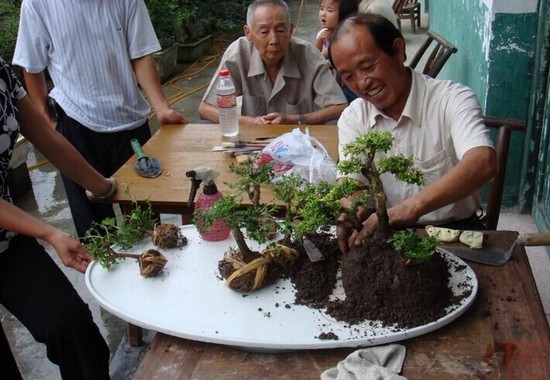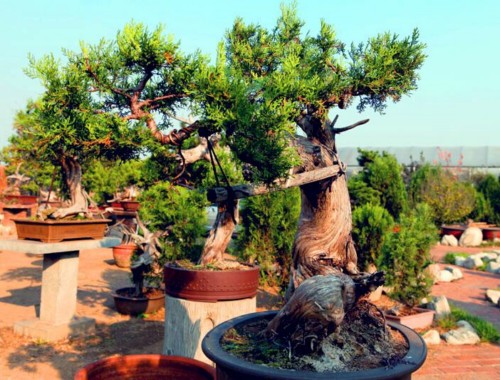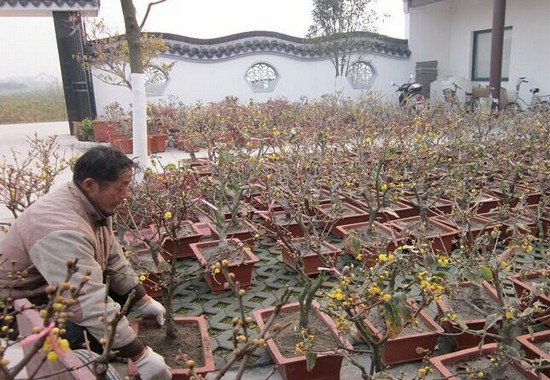How to model bonsai? Bonsai modeling method
Bonsai is a kind of furnishings with a long history in China. It is a kind of arboreal plants, herbs or water, stones, etc., which are planted or arranged in pots after artistic processing to make them a miniature of nature. According to different materials, bonsai can be divided into two categories: tree toona bonsai and landscape bonsai. Bonsai has high ornamental and artistic characteristics and is deeply loved by people.

Bonsai can be called a miniature of nature's big trees. In other words, it is to re-display the natural style of ancient and famous trees with beautiful trees in the wild in the mountain forest in a limited pot. Therefore, the size of the trunk, the size of the leaves and the uniformity of the tree shape have a lot to do with visual harmony.
1. Root plate
The primary condition for fine bonsai is the root plate. The root plate can be said to be necessary and very important in the whole creation of bonsai natural tree type. Whether the root plate is beautiful or not has a decisive influence on the artistic value and appreciation value of the work. The beautiful root plate referred to in bonsai is the root of the ground below Longji, extending towards all sides, sometimes curved, sometimes hidden in the ground, tightly lying on the ground, so as to keep the potted tree from shaking. Often said "four-sided root plate" is the best root plate.
II. LONGi
Under normal growth conditions, the junction between the trunk and the root, with a few exceptions, should be a natural foundation. Specifically, the root plate is about three inches long. The trees used to make bonsai were originally grown in the mountains and rivers. When the wind and rain hit, the trunk would bend more or less, especially the trees growing on the cliff. The trunk bending degree was sometimes extremely large, but the base part was not affected by external forces. Generally, the trunk of potted trees is upright. Sometimes, when changing the curvature of the base for tree type needs, it is better to have an appropriate degree without obvious feeling of incompatibility with nature, because the base is the same as the root plate, which is one of the indispensable conditions for displaying the beauty of potted plants.
III. Trunk
If bonsai is compared to a person, then the trunk is the body of bonsai, which is the basic condition for shaping tree type. Natural and normal trees, the trunk into the root the thicker, the more to the top of the tree on the thinner, this kind of thick and thin natural shape of the round stem, is the most ideal. Whether the trunk is larger and more beautiful or smaller and more elegant depends greatly on individual appreciation. However, the thickness of the trunk should depend on the overall tree structure, and must be coordinated with the root plate, long base, branches, leaves, etc. Regardless of the thickness of the trunk, as long as it can be coordinated with the overall tree posture, it can naturally exert a balanced aesthetic feeling. Generally speaking, the thickness of the trunk should be reconciled with the age of the tree, so as to show the beauty of the depth of the bonsai.
III. Trunk
If bonsai is compared to a person, then the trunk is the body of bonsai, which is the basic condition for shaping tree type. Natural and normal trees, the trunk into the root the thicker, the more to the top of the tree on the thinner, this kind of thick and thin natural shape of the round stem, is the most ideal. Whether the trunk is larger and more beautiful or smaller and more elegant depends greatly on individual appreciation. However, the thickness of the trunk should depend on the overall tree structure, and must be coordinated with the root plate, long base, branches, leaves, etc. Regardless of the thickness of the trunk, as long as it can be coordinated with the overall tree posture, it can naturally exert a balanced aesthetic feeling. Generally speaking, the thickness of the trunk should be reconciled with the age of the tree, so as to show the beauty of the depth of the bonsai.
V. Bark properties
Bark is like human skin, there are many kinds of longitudinal split peel thick skin, tortoiseshell shape of the tortoise shell is rock like overlapping rock...... alone to see these bark has no beauty to speak of, but with the trunk, root plate and overall tree posture contrast, can show charming simple, vigorous atmosphere.
VI. Leaf sex
The shape, nature, size, etc. of the leaves of bonsai are collectively referred to as leaf sex. Leaves are indispensable to bonsai. Because a potted tree often has different perceptions depending on the good or bad nature of its leaves, especially deciduous trees of miscellaneous trees. When spring comes, new buds begin to appear on the branches, and then the leaves open. In autumn, the leaves gradually turn yellow and finally fall off. From the changes of the four seasons of the leaves, people can clearly understand the transfer of the four seasons, and feel the beauty of natural wind color.
Trees in nature, due to the different growth environment of plants, the posture of trees changes thousands, reflected in the form of tree bonsai is more colorful. From the angle of modeling of potted trees, we summarize and combine similar or similar potted plants, and then classify and explain them according to the changes of trunk and the number of trees.
(i) Straight dry
Bonsai trees have only one trunk, and the trunk posture is basically upright or slightly curved, that is, the so-called straight meaning is called straight dry. Straight dry bonsai trees, the best performance of the root requirements must be in all directions have to extend around the thick roots, so that the trees appear solemn and stable, there is an indomitable momentum. Branches extend around, rich in layers, strong branches.
Branches should be about 1/3 or 2/3 of the height of the trunk, branches and leaves should not be too many, so as not to block the trunk. To let the trunk more bare, to show the upright pot tree and vigorous. The flowerpot should be shallow, and the planting position depends on the tree shape. Pay attention to the asymmetric balance between the tree and the pot.
If the crown is an isosceles triangle, the planting position should be centered and backward; if the crown is slightly scalene triangle, the planting position should be slightly inclined to the short side of the triangle. Straight dry tree bonsai should be made into towering "straight frame" picture works, branches should be short. The tree species suitable for straight and dry works are black pine, five-needle pine, golden larch, metasequoia, ginkgo, elm and so on. Most of these materials are taken from forest nurseries, and some are dug up from the mountains.
(2) Qugan
The bonsai trees with curved stem require a certain degree of bending change in the trunk, but the curve should not be more, one or two bends are enough. Music should avoid too monotonous repetition, otherwise there are artificial traces.
Qu Gui is alive, live in the trunk line changes have rigid and soft, rigid and soft, the line is smooth and tactful and straight and vigorous. The dry material of mountain collection is unpredictable, vigorous and natural, very valuable, but there are also unsatisfactory line changes, pay attention to selection.
Artificial cultivation of curved stem material, planting trunk must be slightly inclined, so that the other side of the root culture into strong roots and semi-exposed in the soil surface, and make the root direction and trunk connection has a smooth and coordinated feeling. This is the most important ornamental part of the bonsai of dry trees and must be taken seriously.
For the part above the base of the trunk, it can be truncated by cutting, allowing the trunk to choose another direction of development. In the future, the trunk can also be cultivated to meet the requirements of bonsai beauty by means of shearing and binding. Cypress is the most typical dry bonsai material. Other tree species such as pine and some miscellaneous trees are also suitable for composing dry bonsai.
(III) Oblique dry type
The tree trunk in nature tilts, mostly caused by strong wind blowing or landslides. Therefore, the form of tree trunk inclination is also very complicated, but there is one point, its trunk line is not a straight line, but a variety of "S" shape deformation. This inclination of the trunk in nature is reflected in the potted trees, which we call inclined dry.
Oblique dry bonsai material trunk must have "S" shape of various deformation. If the trunk is right, then the left side should have thick roots, and the trunk dry shoots turn upward, which is like inclined dry bonsai material for many years. If the trunk is inclined and the trunk line is straight, it lacks charm and does not conform to the laws of nature. Because there is no day when the wind is strong, and the trees always have to continue to grow upward.
The key point of making inclined dry tree bonsai is how to make the tree lose its center of gravity and achieve balance. The methods include: play the role of thick roots in opposite directions, play the role of branches in opposite directions and fall of large branches inclined in the same direction, giving people a feeling of support. In order to strengthen the intensity of pot tree tilt, make composition active, should choose round shallow basin, square shallow basin or semi-high round basin, let inclined trunk or branch beyond the basin. Coniferous trees and some miscellaneous trees are suitable as materials for inclined dry bonsai.
(iv) Cliff-style
On the cliffs of nature, some trees grow in various poses, but they are still flourishing. This attitude of trees is reflected in the bonsai collectively referred to as cliff style.
Cliff-style is generally semi-suspended, fully suspended and upside down, and so on.
Semi-suspended type: bonsai trees are all over the pot, born in the sky, but the tree body is not lower than the pot surface. It may be that the trunk is horizontal, or it may be because the trunk is shorter and the first branch is thicker and longer, thus taking advantage of the air.
Full suspension: bonsai trees whole plant beyond the pot, and for downpour downward extension and branches out horizontally.
Upside-down type: bonsai tree whole plant beyond the pot, bare trunk vertical upside down, branches are still horizontal out.
Cliff-style bonsai production focuses on material selection, requiring the base of the trunk of the material to have a certain bending change, so that the trunk or large branches can follow the trend of horizontal or drooping. Although cliff-style bonsai is popular, it cannot be considered according to the material conditions, and the modeling principle of "adapting to materials" should be followed.
Cliff-style potted plants used to be planted in pots to set off the momentum of trees falling from heights. Now switch to half-high square pots or round pots for planting, and then use several high frames to create cliff momentum when arranging exhibitions. Its advantage is that it can improve the cultivation management of trees caused by too deep stem tube; it can make the scene, basin and frame trinity in viewing, and show it vividly, so that the picture is transparent, harmonious and vivid.
(V) Double dry type
The double-dry tree bonsai appears in the form of two trees combined together, reflecting the artistic beauty of modesty and coordination between the two trees, looking around and echoing, proper density and emptiness, thus showing the realm of both form and spirit and blending of emotion and scene.
Double dry bonsai production must pay attention to the following points.
1, the selection of two trees must have primary and secondary points.
The main tree should be taller and the secondary trees shorter. The posture of the main tree is dominant, and the posture change of the trunk of the secondary tree is similar to or close to that of the main tree to form a certain tacit understanding. If the two tree trunk posture changes are completely different, such as a song, it is difficult to produce the beauty of coordination, should be avoided.
2, planting two trees must be before and after, not parallel.
Who comes first depends on the circumstances. When planting, the base of the trunk of the two trees should be close together, and the roots of the trees should be basically consistent, not east and west respectively. The angle of extension direction of two tree trunks should not be too large, generally within 45° angle is ideal. If it is too large, the two tree trunks may lose each other's echo and look around. Branch processing double-dry branches selection and adjustment is more complex, to the two trees as a unified whole to deal with, in order to achieve overall balance and stability, coordination, competition and order. The lower branches of the two trees should be extended outward, and the thicker branches should be cut off between the two trunks to avoid crossing the thick branches and trunks. The branches between the two trunks should be filled by front and rear branches to avoid straight lines, which is the most natural. In addition, the branches of the main tree should be high, and the branches of the secondary tree can be slightly lower to avoid the branches of the main tree affecting the growth of the secondary tree.
3. Double-stem planting can also be two different tree species, but the best combination is still one tree species.
Double-stem is a combination of two trees, can also be a double-stem form into, collectively referred to as double-stem. Because from a modeling point of view, their trunk processing and branch processing are the same. A double stem, may originally be one, after the impact of external forces and split into two. The height, thickness, straight and straight of the two trunks, as well as the change of hidden dew, are very consistent with the performance requirements of bonsai art. Relic stem is also natural, slightly decayed decoration. God's Word is indispensable, but man-made. Ideally, both waterlines are wide and both grow outside the trunk. The crown is closely combined by two crowns, and its potential is unified with the two stems. The whole tree is suitable for movement, compact structure, stable, quiet, unified and harmonious beauty.
Time: 2019-06-12 Click:
- Prev

The Main Points and Modeling Techniques of Platycladus orientalis Bonsai Scenery
Picking shoots and relics are important skills to master in making Platycladus orientalis potted landscape. Picking shoots is actually pinching leaves. Because the young branches of Platycladus orientalis are grown from scaly leaflets, they can be controlled by pinching the young branches and leaves. At the same time, it is also the only choice to organize the ten states, standardize the tree appearance and clean the landscape.
- Next

Teach you to cultivate wintersweet bonsai quickly.
Chimonanthus is a deciduous shrub with opposite leaves, rough leaves, and flowers on new branches (that is, annual branches) born in the axils of previous annual branches. The flowering period is from December to February, and the fruiting period is from August to September of the following year. Its adaptability is strong, drought resistance, cold resistance, like light, like fertilizer, not resistant to bituminous coal. Resistance to pruning
Related
- Fuxing push coffee new agricultural production and marketing class: lack of small-scale processing plants
- Jujube rice field leisure farm deep ploughing Yilan for five years to create a space for organic food and play
- Nongyu Farm-A trial of organic papaya for brave women with advanced technology
- Four points for attention in the prevention and control of diseases and insect pests of edible fungi
- How to add nutrient solution to Edible Fungi
- Is there any good way to control edible fungus mites?
- Open Inoculation Technology of Edible Fungi
- Is there any clever way to use fertilizer for edible fungus in winter?
- What agents are used to kill the pathogens of edible fungi in the mushroom shed?
- Rapid drying of Edible Fungi

